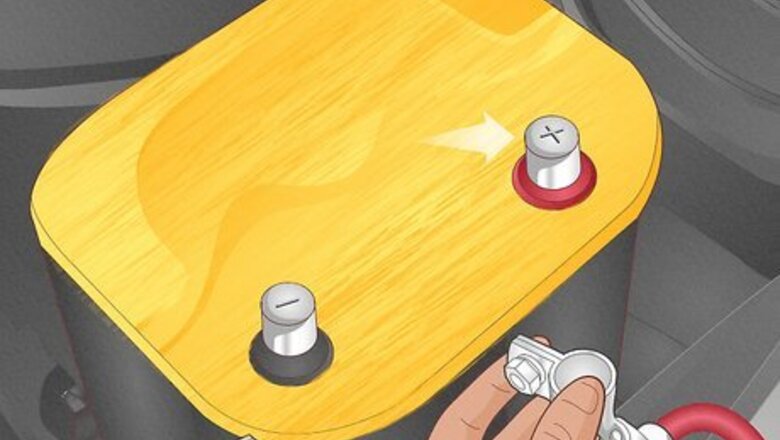
views
- The terminal marked “+” or colored red is the positive one. The “+” may be on the terminal or stamped on the battery casing.
- The negative terminal is often black and marked “-”. The battery casing next to the terminal should also have a “-” stamp.
- If your battery has poles but no markings, check their widths. The smaller of the two is the negative terminal.
Determining if a Terminal is Positive or Negative
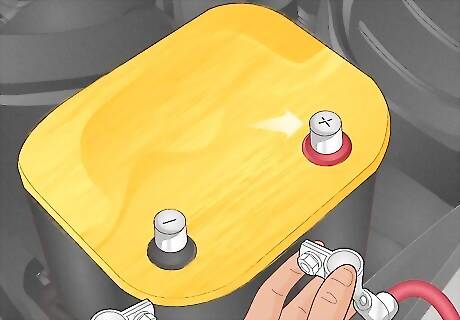
Check for a red terminal with a “+” sign. Many batteries are color-coded–red for positive and black for negative. The terminals are also often marked “+” for positive and “-“ for negative.

Look on the battery casing for a “+” or “-“. If the terminals are the same color or aren’t marked, check the battery casing for a stamp. Negative terminals have a “-“ and positive terminals have “+”.

Check the width of the poles. If all the markings on your battery have worn away, there’s a chance you can still determine which terminal is which. If you have two straight posts sticking out of your battery (and not bolts or L-shaped posts) the smaller terminal is negative.
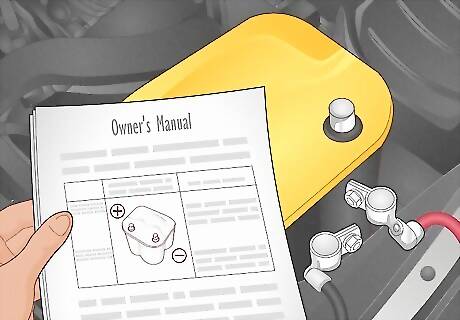
Consult your owner’s manual. If all else fails, check your owner’s manual. It’s incredibly important to connect terminals correctly when you’re replacing your battery or jumpstarting your car, so make absolutely sure you know which is which. If you don’t have your owner’s manual, look up the make and model of your car online to get a digital copy.
Jumpstarting Your Car
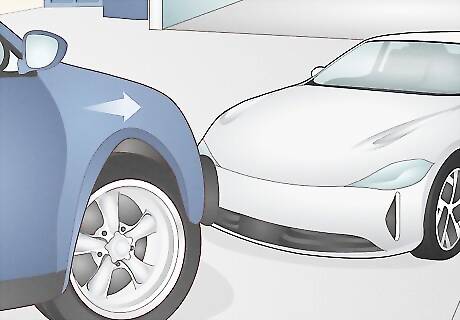
Park another vehicle by your car and turn everything off. Park the other car close enough that a set of jumper cables can reach both batteries. Cut the engine on the booster car and turn off all the accessories in both cars, like the interior lights, radio, and AC. Most cars have their batteries under the hood, but some may have the battery in the trunk. Consult your owner’s manual before jumpstarting your car if you’re not sure where yours is. Put on safety glasses and gloves, if you have them.
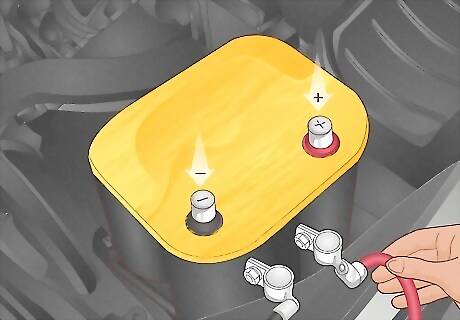
Find the battery terminals. Pop the hood or open the trunk to expose the batteries, then check for “+” and “-“ signs to determine which is positive and which is negative. The terminals may also be under plastic caps. If so, the red cap is positive and the black is negative. If the terminals have any white or green crust on them, wipe it off with tin foil or a wire brush. Don’t use your hands.

Connect the red clamps to the positive battery terminals of both cars. Clip a red clamp onto the positive terminal of the dead battery, then attach the other red clamp to the positive battery terminal of the booster car. Always follow this exact order when attaching your clamps. Putting the clamps on out of order can damage the battery and your car’s electrical system. Don’t let the clamps touch each other at any point. It could damage your car or give you an electric shock.
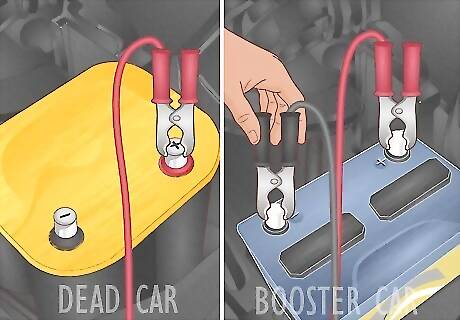
Attach a black clamp to the negative terminal of the booster car. Clip one of the black ends of the cable to the negative battery terminal of the car giving a boost. Never connect a cable to the negative terminal of the dead battery.

Attach the other clamp to an unpainted piece of metal on the dead car. Connect the other black clamp to an unpainted piece of metal in the engine or on the chassis, at least a foot away from the battery. Check that the connections of all the clips are tight and that the cables aren’t near anything that moves.
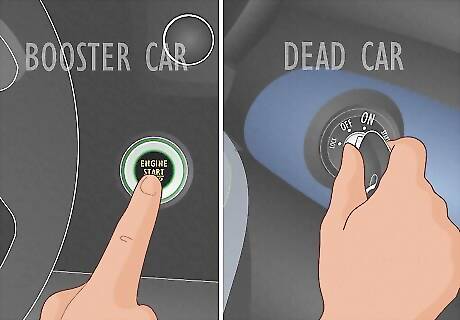
Start the booster car, then start the dead car after a minute. Run the engine of the booster car at 1,500-2,000 RPM for a minute or so, then turn the ignition in the dead car. If the car doesn’t start, run the booster engine for a few more minutes, then try again. Don’t try to start your car more than 3 times in a row, or you could damage the electrical system. If your car still won’t start, there may be larger problems with your electrical system, or you may need a new battery.
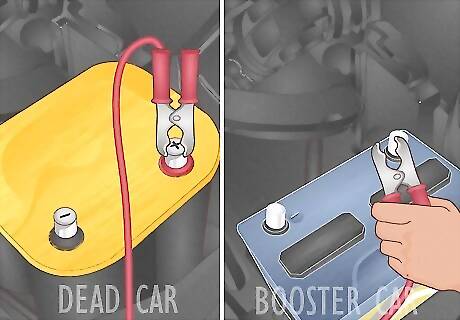
Detach the cables in reverse order once the engine is running. When the dead car’s engine is up and running smoothly, take off the jumper cables. Take off the black clip on the car that needed a boost, then the black clip on the good car, the red clip on the good car, and the red clip on the newly charged battery.
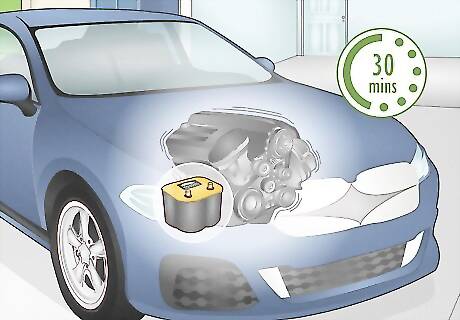
Run the engine for at least half an hour. Put away your jumper cables and close the hood, then drive your car or let it idle with the lights off for 30 minutes. This gives the alternator time to charge your battery.
Changing a Car Battery

Find your car’s battery and determine which terminal is which. Park your car in a clear, safe area and turn it off. Depending on the model of your car, pop the hood or open the trunk to find the battery. Look for a red cap or “+” on the battery to determine the positive terminal. If you can’t see the “+” or “-” but there are two posts coming from the battery, the smaller one is the negative terminal. Wear safety glasses and thick gloves while changing your battery. Check your user manual to make sure you get the correct replacement battery. Automotive specialist Hovig Manoucheckian warns that people often get batteries that “[are] not the correct size, [don’t] meet the specifications of the vehicle, and…[move] around when the car’s being driven.”
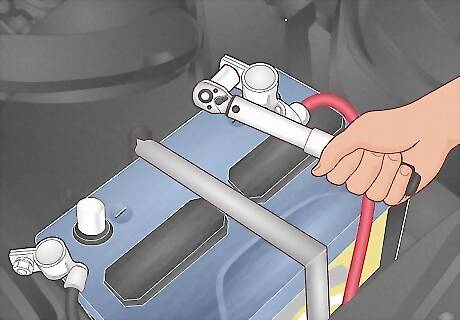
Disconnect the negative terminal, and then the positive one. Use an adjustable wrench or deep well socket wrench to take the release nut off the negative terminal, then the positive one. The nut is on the cable terminal next to the post. Once the release nut is loose, remove the wiring around the posts. The wires are what actually connect the battery to the car.
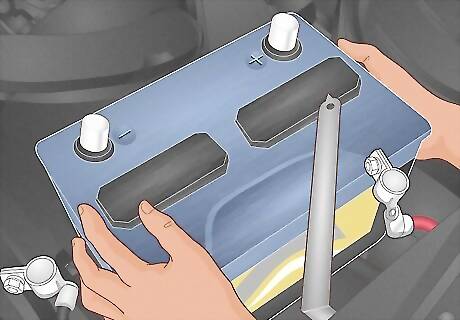
Remove the bracket and take out the battery. Use your wrench to loosen the bolts on either side of the bracket that holds the battery in place. Batteries are very heavy, so use the built-in handle to lift it up, or grip it tightly before you take it out.

Clean the terminals and connect a new battery. Use a small wire brush to remove any crust from the cable terminals, then put in the new battery. Attach the positive terminal first, then the negative one. Spray lithium grease on the battery terminals to help prevent corrosion. Check the casing on the battery before attaching the terminals. According to Manouchekian, one of the most common mistakes is when “[someone] connects the battery cables backward. [Basically,] they put the positive cable to the negative posts on the battery.” If your car doesn’t seem to be running normally after changing your battery, contact a professional.
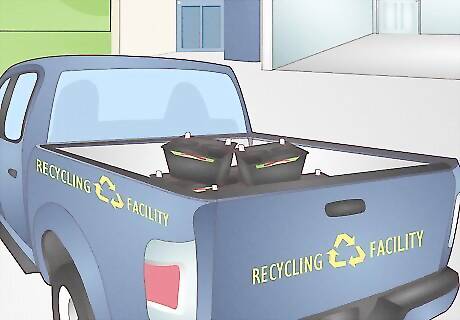
Recycle the old battery. Batteries are hazardous waste, and should never be thrown away. Contact a mechanic or an automotive store to learn about recycling options in your area. Battery recycling is often free. Car batteries can leak, so store them upright before recycling.



















Comments
0 comment